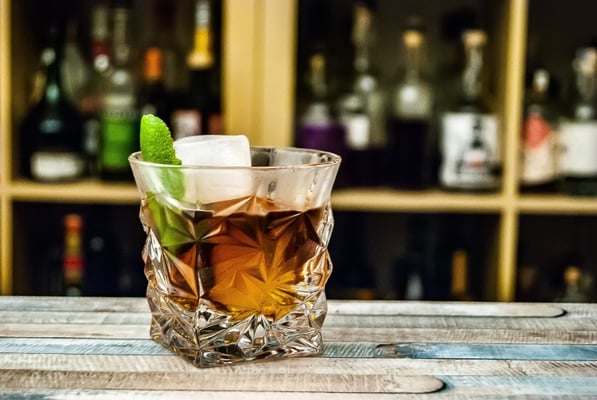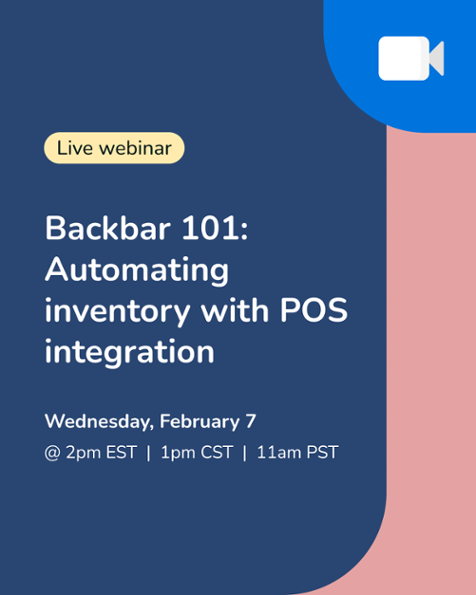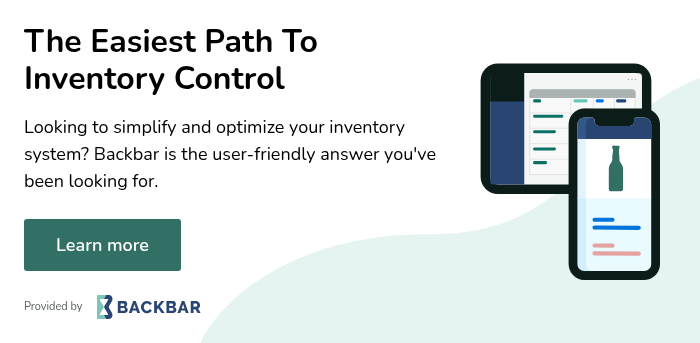A well run bar should have an alcohol cost between 18-20% of sales. It's the golden range for bar managers and beverage directors. And, like baseball players striving to have a .300 batting average, many bar professionals spend their days chasing this number. It can be difficult. Especially if you're taking over a beverage program carrying a ton of dead stock, poorly priced drinks, or untrustworthy employees. But it can be done. Here's how to get your pour cost down to 18%.
Liquor cost formula
Liquor costs, also called pour costs, are the ratio between the cost of products purchased and the revenue from products sold.
Read our post on Bar Inventory for more information about liquor cost and other important bar inventory formulas.
Product Costs / Product Sales = Liquor Cost
Your pour cost is important because if it is too high, then you will generate lower profits overall from beverage sales. Pour costs have an inverse relationship to margin.
Another way to state margin, is that for every extra dollar in sales you make, the margin is the incremental gross profit (profit before other expenses such as fixed costs, labor, utilities, etc...).
Your margin percentage is calculated as:
(Sales - Costs) / Sales = Margin
How to calculate pour cost [video]
Average pour costs for bars and restaurants
Looking at industry costs is a good guideline, but depending on your business, you will want to determine the ideal pour costs and margins for you. A business in a major metropolitan city with high rents and labor costs will need lower pour costs and higher margins than one that isn't.
Here are industry averages for pour costs:
|
Liquor: 15% |
Draft Beer: 20% |
Bottled Beer: 25% |
Wine: 30% - 40% |
Average Total: 18% - 24% |
Now that you can identify what your pour cost is, let's dive into 5 ways to lower your liquor cost.
Building a purchasing budget for your bar
One of the best ways to track your liquor and beverage costs is to create a depreciating budget that puts a cap on your alcohol spending per month and tracks your purchases each week. This style of budgeting will make sure you're only purchasing what you should and what is profitable for the business.
How do you figure our what your budget should? First you need to find out your Cost of Liquor Sold. This takes some math, due diligence, and a week of business.
Track the numbers in this equation over the course of a week:
Standing Inventory Amount + Cost of Purchases - Closing Inventory Amount = Usage Amount
Usage Amount / Sales Revenue = Cost of Liquor Sold %.
To start your budget, you need to take inventory of every bottle and keg at your restaurant.
But your standing inventory isn't just the bottle count: you must record the dollar value of each item.
Once you find out the $ value of your standing inventory, then you can start to build your budget. When you're building your budget, use an inventory app or excel spreadsheet to track the necessary information.* All the information you need is on the invoice you receive from your distributor.
* Record the distributor, date of invoice, date of payment, invoice total, invoice number, and check number if paying by check, so you have accurate information to reference.
Now, after the week is over, you must perform inventory again. This number is your closing inventory. Use the equation above to find your usage amount. Divide the usage mount by your sales revenue for the week and you will get your liquor cost of goods sold percentage.
Here's an example:
Standing inventory: $12,050
Liquor purchases: $2,070
Closing inventory: $9,075
Liquor Sales: $24,000
12,050 + 2,070 - 9,075 = 5,045
5,045 / 24,000 = 21%.
So, in this example, you're in a good position with a 21% liquor cost.
Projecting liquor sales
The next step in building a depreciating budget is defining your sales projection for each week. This number should be based off the volume of business at your bar, your average weekly sales, and any events, holidays or other variables like weather and season that may affect sales. Define your projected sales, and keep your purchases in line.
If you're projecting $24,000 in liquor sales per week, and kept your weekly purchases around $2,070 per week, then you should cap your spending at around $8,280 per month. So $8,280 is your budget. To work the depreciating budget you start with this number and subtract your liquor purchases each week from this number. A goal should be to reduce your standing inventory to give you more spending power to purchase products you know will
move across the bar.
Here's an example:
Week 1 budget: $8,280
Week 1 purchases: $2,070
Week 2 budget: $6,210
Week 2 purchases: $3,080
Week 3 budget: $3,130
Week 3 purchases: $2,050
Week 4 budget: $1,080
Week 4 purchases: $2,070
End of month spending: -$990
In this example you went over your budget by $990. This could be a bad thing. But you might have had a really strong week 1 for the month with sales higher than the projected $24,000. This might have been why you spend $3,080 in your week 2 purchases.
The benefit of a depreciating budget is that it makes your hyper aware of your purchasing costs. The restaurant and bar industry needs to be flexible because there are so many variables to contend with, but using this budget system will help you prepare for when those negative variables pop up.
Standard cocktail pours
Many people focus on employee theft as a major reason to put liquor control standards in place. But, there are other factors aside form your employees stealing. And, for the purpose of this post, I'm going to assume that you take the time to employee trustworthy bartenders and staff.
Outside of the obvious suggestion to stop hiring thieves, here are 3 ways to control liquor portions.
Use jiggers at your bar
Some veteran bartenders might scoff at the thought of using jiggers, or measuring devices, to buils drinks. But making sure you pour the correct amount of tequila into every margarita you make is good for business. You can avoid over pouring with jiggers. Not only that, but using jiggers to standardized pours will create consistent and high quality cocktails. I know a lot of bartenders like to count to free pour, but as a business owner, you need consistency and certainty that your staff is accidentally over pouring liquor.
Pre-batch your house cocktails
Pre-batching cocktails creates consistent tasting cocktails, speeds up service, and allows you to measure out your liquor and make sure your portions are in control. It's a great way to create a more efficient bar and will significantly reduce liquor shrinkage and ticket times.
Cocktail recipe cards
In addition to creating cocktail cards to cost out ingredients, you should have a rolodex of index cards or a book of common cocktails and what the standard house recipe is. This lets bartenders know the correct portions of alcohol to be used when someone orders a manhattan or a ramos gin fizz.
Electronic Pour Spouts
These are a very efficient way to track your pours, and to ensure that pours are consistently the right ounce per drink. You can also track pour data with these. They are certainly useful tools. But they ruin the atmosphere of a bar. Unless you're running a bar at an airport, then stay away from electronic pour spots which scream "I don't trust my employees."
Conduct a weekly alcohol inventory
You should be tracking your inventory weekly. This was mentioned above as a prerequisite to using a depreciating budget. Even if you don't go that route, you should be tracking your inventory each week.
This is more than just putting together an order for your distributors. You should be counting all inventory. You should be assigning a dollar value to all of that inventory as well.
Track these numbers so you can compare your week-to-week inventory. Ditch the pen and paper and enter these numbers into your computer or use an inventory app. Make sure to take note of items that aren't selling. Find ways to promote and sell these brands, and then stop carrying them. See which items are selling each week, and trim your selection down to highlight these high volume items.
Build relationships with your distributors
Liquor laws are convoluted and differ from state-to-state. Be aware of what you legally can and can not do when purchasing and selling liquor. Build strong relationships with your distributors and try to get case and volume discounts on high selling items that you know will move.
Here's an example:
If you run a weekly special on Jameson and are consistently ordering cases of it, then work with your distributor to get a discount for your high volume orders.
Analyze your weekly inventory and orders to see how many cases of Jameson you purchase per month or per quarter. If your purchases and sales are consistent, then make a deal with your distributors that you will purchase X amount cases of Jameson per month, (or whatever timeline works best for you) and in return you will get a discount or no-charge on Y number of cases of Jameson.
Work with your distributor to get these discounts on any bottle you use in your well, any liquor that's a base for a popular cocktail, and any wine you have your glass pour list.
Liquor distributors love to see their products on menus and be used in high volume. They will be happy to work out a deal with you to keep you ordering their products for the long term.
No 1/2 Price Bottles of Wine Specials
This is a promotion that you often see at restaurants. And, I've often seen it run at restaurants that soon close their doors. This loss-leader is enticing. Get people to come to your restaurant to order bottles of wine and they'll likely stay for dinner. It sounds attractive, but wine has offers one of the highest profit margins for restaurants with industry mark ups of up to 4x the cost of bottles. These types of promotions eliminate the value of one of your best tools to generate revenue.
If you're looking to drum up more business, there are other ways to do so without hurting a great revenue stream.
If you're looking to reduce your wine inventory with one of these promotions, don't do it. You're better off creating wine pairings or and flights with your dead stock in order to sell it. Or, offer the wine as a special on a Friday or Saturday night. Look to move dead inventory on the nights when you're the busiest so your servers can promote these bottles to the most amount of people.
A great way to encourage servers to push wine is to run a sales competition where the server who sells the most bottles of a given wine wins a prize. The prize can be as simple as a bottle of that same wine, a gift card, or a earning a cash prize of a percentage of their sales. Smart promotions sell wine. Selling wine for cheap kills your business.
A Good Liquor Cost is a Combination of Factors
Keeping your bar cost low doesn't mean ordering cheap alcohol. It means you're tracking your numbers and making smart decisions to get the best results. It takes some due diligence, especially if you're trying to improve a poorly run program, but you can do if you follow the right steps.




